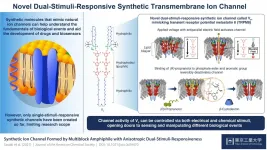New protein neutralizes COVID in tiny human kidney
Modified ACE2 tricks virus into binding with it instead of real cell
2021-02-01
(Press-News.org) Decoy protein intercepts spike of coronavirus
Virus prevented from infecting human cells
Protein may be new way to treat and prevent COVID-19
CHICAGO --- Northwestern Medicine scientists have developed a new protein that acts as a trickster to neutralize the COVID-19 infection in a human kidney organoid, a miniature organ made from stem cells in the lab.
The protein is a variant of ACE2 (angiotensin converting enzyme-2), the receptor the coronavirus uses to enter and infect human cells. The modified protein intercepts the S spike of the coronavirus and fools it into binding to it rather than the real ACE2 receptor in cell membranes.
"The idea was to administer our protein to intercept the coronavirus before it gets to the natural receptor in the cell membranes," said lead study author Dr. Daniel Batlle, a professor of medicine at Northwestern University Feinberg School of Medicine and a Northwestern Medicine physician. "To make it more efficacious, we modified the ACE2 protein to extend its duration of action from hours to days. That feature will be critical for patient use."
The study was published Feb. 1 in the Journal of the American Society of Nephrology.
The findings are proof of concept that the ACE2 protein will be effective in preventing and treating COVID-19 infection in humans, said Batlle, also the Earle, del Greco, Levin Professor of Nephrology and Hypertension at Feinberg.
"While widespread vaccination is the best way to combat the COVID-19 pandemic, there will always be a need for therapies for prevention and treatment of people who were not vaccinated or for whom the vaccine was not fully effective," Batlle said.
The protein was tested in the human kidney organoid because rodents are resistant to infection by the coronavirus causing COVID-19.
Batlle's lab has studied ACE2 for many years as part of a potential treatment for kidney disease. Batlle and study co-author Dr. Jan Wysocki, research assistant professor of medicine at Feinberg,
have bioengineered novel ACE2 variants licensed to Northwestern University which they believe can be adapted for COVID-19 therapy by intercepting the coronavirus and preventing it from attaching to the natural ACE2 receptor in the membrane of the cell.
The next steps involve the planning of safety studies needed before Investigational New Drug approval for future studies in patients with COVID-19.
INFORMATION:
The study was supported in part by grant RO1DK104785 from the National Institute of Diabetes and Digestive and Kidney Diseases of the National Institutes of Health and the Joseph and Bessie Feinberg Foundation.
ELSE PRESS RELEASES FROM THIS DATE:
2021-02-01
NEW YORK, NY (Feb. 1, 2021)--Errors in the way chromosomes are packed into antibody-producing B cells appear to play a role in the development of B cell-related blood cancers, according to a new study by researchers at Columbia University Vagelos College of Physicians and Surgeons.
The findings could lead to new biomarkers for predicting the onset of these cancers and to a new class of cancer therapies that prevent or correct harmful changes in genome architecture.
The study was published online Feb. 1 in the journal Nature Genetics.
Antibodies are made by immune cells called ...
2021-02-01
Taking a particular type of medication to treat enlarged prostate is associated with a reduced risk of developing Parkinson's disease, according to a large observational study led by researchers at the University of Iowa, with colleagues in Denmark and China.
The findings, published Feb. 1 in JAMA Neurology, provide compelling evidence that terazosin, and similar medications, might have the potential to prevent or delay the development of Parkinson's disease.
The new study used data on almost 300,000 older men from two large, independent patient datasets--the Truven ...
2021-02-01
A new kind of wearable health device would deliver real-time medical data to those with eye or mouth diseases, according to Huanyu 'Larry' Cheng, Dorothy Quiggle Career Development Professor in the Penn State Department of Engineering Science and Mechanics (ESM).
Cheng recently published a paper in Microsystems & Nanoengineering on new micro- and nano-device technology that could revolutionize how certain health conditions are monitored and treated.
"We sought to create a device that collects both small and large substances of biofluids such as tears and saliva, which can be analyzed for certain conditions on a rapid, continuous basis, rather than waiting on test results from samples in a lab," he said.
The sensors would be placed near the tear duct or mouth to collect samples, ...
2021-02-01
Winter survival of honey bee colonies is strongly influenced by summer temperatures and precipitation in the prior year, according to Penn State researchers, who said their findings suggest that honey bees have a "goldilocks" preferred range of summer conditions outside of which their probability of surviving the winter falls.
The results of this study, which used several years of survey data provided by the Pennsylvania State Beekeeper's Association and its members, enabled the development of a tool for forecasting honey bee winter survival to support beekeepers' management decisions, the researchers said.
Honey bees contribute more than $20 billion in pollination services to agriculture in the United States and generate another ...
2021-02-01
Toxin-antitoxin (TA) systems are now known to negatively control plasmid replication, according to Thomas Wood, Biotechnology Endowed Chair and professor of chemical engineering in the Penn State College of Engineering.
Plasmids, or extra-chromosomal bits of DNA, allow bacteria to evade antibiotics, making the antibiotics ineffective in halting a bacterial infection.
The presence or absence of plasmids impacts a bacterium's resistance to antibiotics and its ability to cause infection -- important points related to fighting bacterial infections, according to Wood.
"Each year, there are at least 700,000 deaths worldwide because of bacterial infections, a growing number that is projected to increase to 10 million by 2050," Wood said. "And of course, the effectiveness ...
2021-02-01
February 1, 2021 - Extracorporeal cardiopulmonary resuscitation (ECPR) is a potentially lifesaving treatment for patients in cardiac arrest when the circulation can't be restored by conventional CPR. New guidelines for ECPR in adults and children, developed by the Extracorporeal Life Support Organization (ELSO), are presented by the ASAIO Journal, official journal of the American Society for Artificial Internal Organs. The journal is published in the Lippincott portfolio by Wolters Kluwer.
A specialized application of extracorporeal membrane oxygenation (ECMO), ECPR is increasingly being used to provide a chance ...
2021-02-01
Imagine a rubber band that was capable of snapping itself many times over, or a small robot that could jump up a set of stairs propelled by nothing more than its own energy. Researchers at the University of Massachusetts Amherst have discovered how to make materials that snap and reset themselves, only relying upon energy flow from their environment. The discovery may prove useful for various industries that want to source movement sustainably, from toys to robotics, and is expected to further inform our understanding of how the natural world fuels some types of movement.
Al Crosby, a professor of polymer science and engineering in the College of Natural Sciences at UMass Amherst, ...
2021-02-01
A key thread that holds together the delicate balance of a complex biological system is the transmembrane ion channel. These are supramolecular, or multi-molecule, ion and molecule exchange routes embedded within cell membranes to ensure essential chemical transport to and from the cell and facilitate cell signaling.
In recent years, synthetic biomolecules that mimic the structures and functions of natural ion channels have garnered much interest among molecular biology researchers as models for studying the fundamentals of these channels and perhaps, even creating drug alternatives or developing advanced biosensors.
However, although ...
2021-02-01
Social media is increasingly used to spread fake news. The same problem can be found on the capital market - criminals spread fake news about companies in order to manipulate share prices. Researchers at the Universities of Göttingen and Frankfurt and the Jožef Stefan Institute in Ljubljana have developed an approach that can recognise such fake news, even when the news contents are repeatedly adapted. The results of the study were published in the Journal of the Association for Information Systems.
In order to detect false information - often fictitious data that presents a company in a positive light - the scientists used machine learning methods and ...
2021-02-01
The adoption of recommended changes in concussion management led to a reduction in the length of symptoms among 11- to 18-year-old athletes with first-time, sports-related concussions, according to new research in the Journal of Osteopathic Medicine. These outcomes support the widespread adoption of the updated concussion guidelines.
Researchers conducted a retrospective review of the medical records of athletes who sustained a concussion between 2016 and 2018 and were treated by a physician who used the revised approach to concussion management. They then compared the data with a previously published data set from athletes who sustained a concussion between 2011 and 2013 and whose physicians followed older guidelines for concussion ...
LAST 30 PRESS RELEASES:
[Press-News.org] New protein neutralizes COVID in tiny human kidney
Modified ACE2 tricks virus into binding with it instead of real cell


